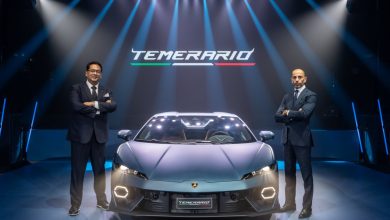Audi RS7 Sportback ‘Performance’ Arrives In Showrooms
The RS7 Sportback ‘Performance’ sits right next to the standard RS7
The Audi RS7 Sportback and the RS7 Sportback ‘Performance’ sit low to the ground. The flared wheel arches emphasize the spectacularly sporty nature of the high-performance model. The noticeable width is no optical illusion – at 1,950 millimeters (76.8 in) at the front fenders, the tape measure has to stretch an extra 20 millimeters (0.8 in) on each side over the Audi A7 Sportback.
The RS7 Sportback and the RS7 Sportback performance share the coupé-like lines of the base model’s body but have only four identical parts: the hood, the roof, the front doors, and the tailgate. The RS-specific exterior design lends the 5,009-millimeter (197.2-inch) grand tourer a character all its own.

The front end of the RS7 Sportback and the RS7 Sportback Performance features a broader and flatter Singleframe than the A7 Sportback, with no contrasting chrome border. The radiator protective grille with its RS-specific three-dimensional honeycomb structure has retained its glossy black appearance. Inspired by the Audi R8 supercar, distinctive air inlets on the front end with glossy black vertical wings emphasize the powerful styling. A horizontal blade marks a distinctive downward edge to the front end.

The side view of the Audi RS7 Sportback and the RS7 Sportback Performance reveals sharply defined lines and curved surfaces appearing like well-toned muscles. A low shoulder line shifts the visual emphasis downward, while the window line rises toward the rear, giving a sense of dynamism even when the vehicle is stationary. The RS specific door sills with black inlays accentuate the high-performance Sportback’s distinct impression of forward movement.

The rear end’s sweeping spoiler lip and strip of lights linking the main rear lights together are among the characteristic defining features of the RS7 Sportback and RS7 Sportback ‘Performance’. At a speed of 100 km/h (62.1 mph), a spoiler will extend from the tailgate. The RS exhaust system, with a large, chrome-colored oval tailpipe on each side, sits beneath an RS-specific bumper with a rear diffuser in gloss black.
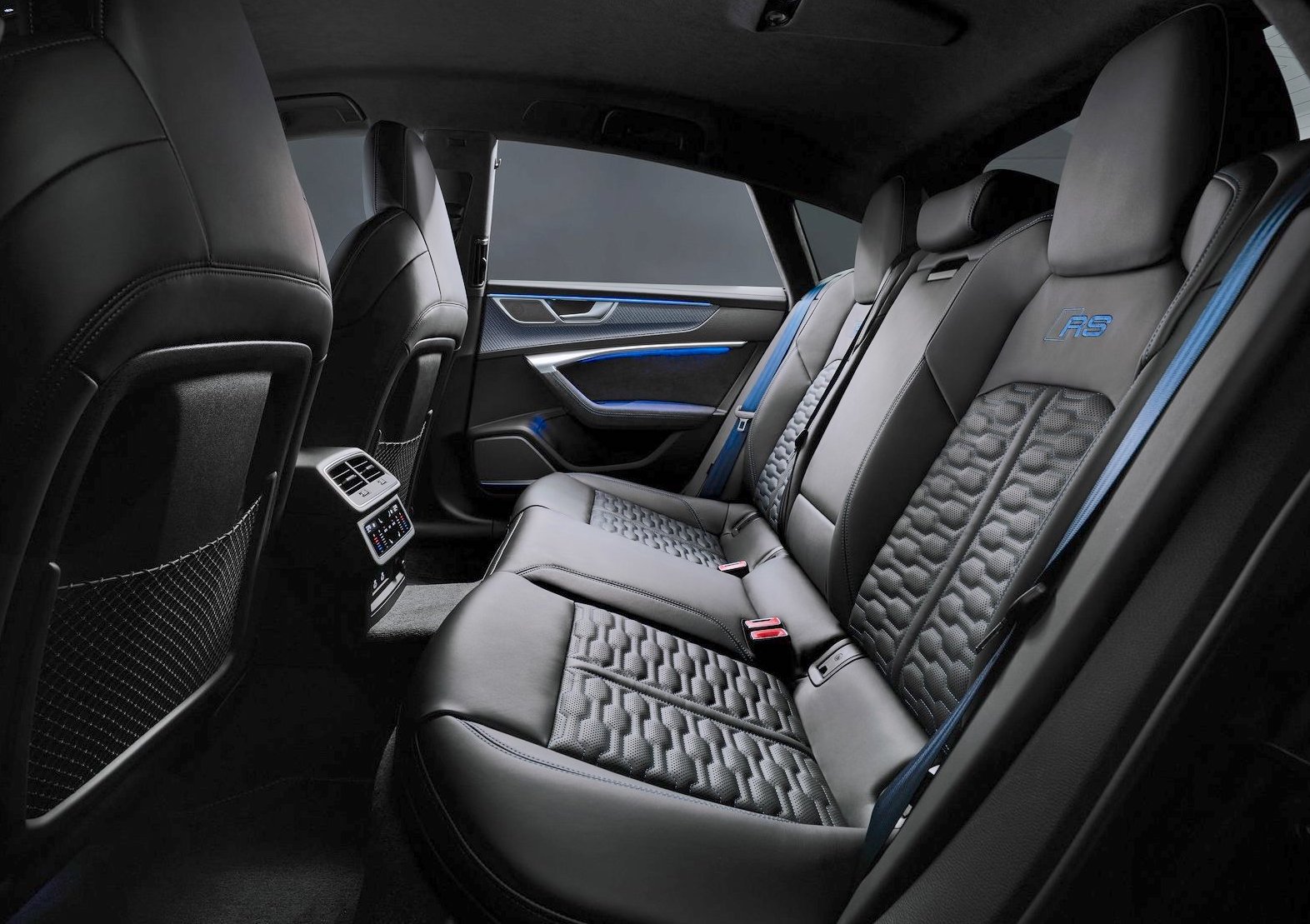
Customers can tailor the RS7 Sportback and RS7 Sportback Performance to suit their preferences, with a wide range of variations and numerous equipment options offering plenty of room for personalization. The range of colors for the RS7 encompasses thirteen exterior paint finishes, including the two RS-specific shades of Nardo gray and Sebring black, crystal effect. There are also five matte effect paint finishes available exclusively for the RS6 and RS7 models.
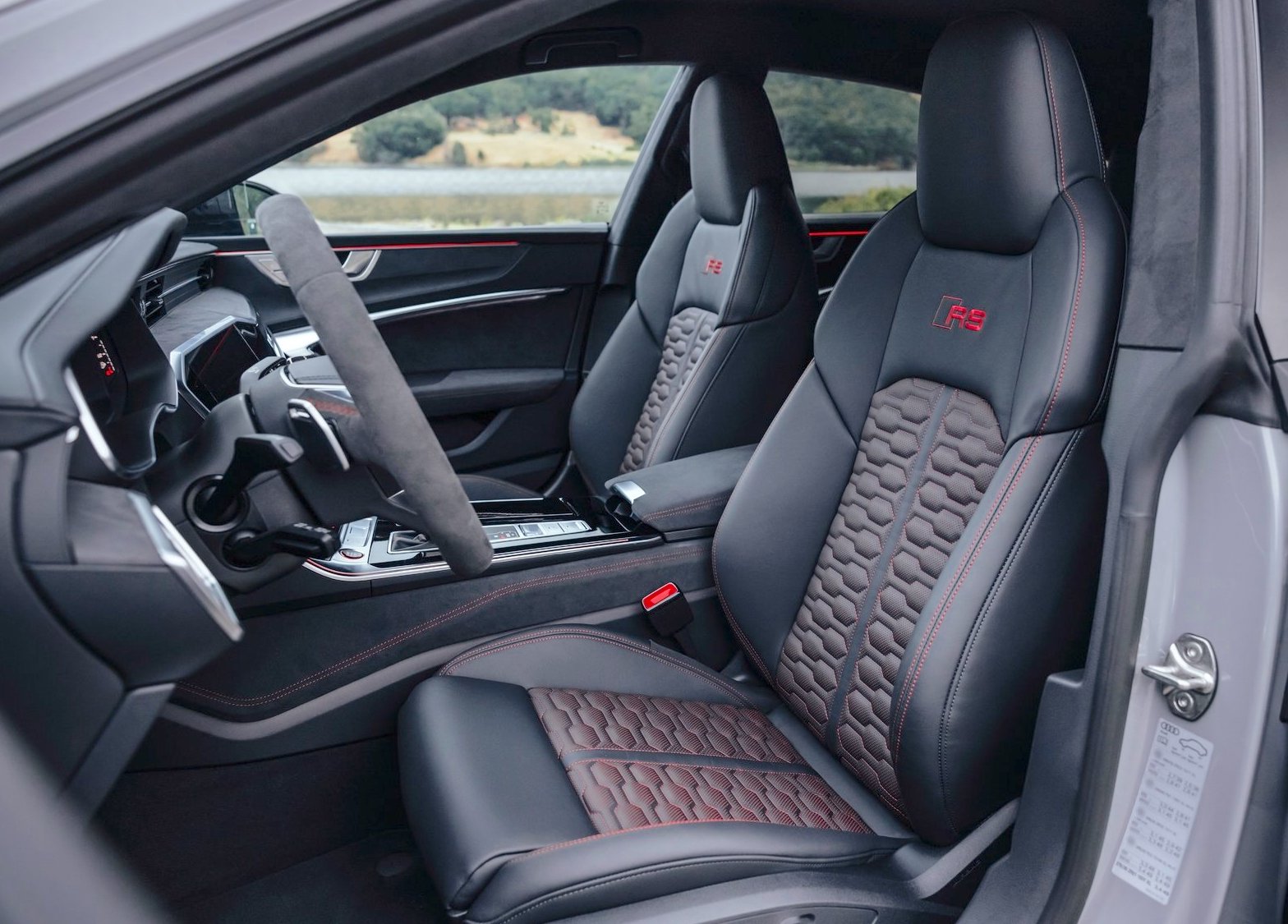
The exterior mirror housings on the RS7 are glossy black as standard, with aluminum matte or body color available as options. Flaps, blades, sill inlays, window slot trims, and the rear diffuser clip can fall under one of three styling packages in matte aluminum, glossy black, or carbon.
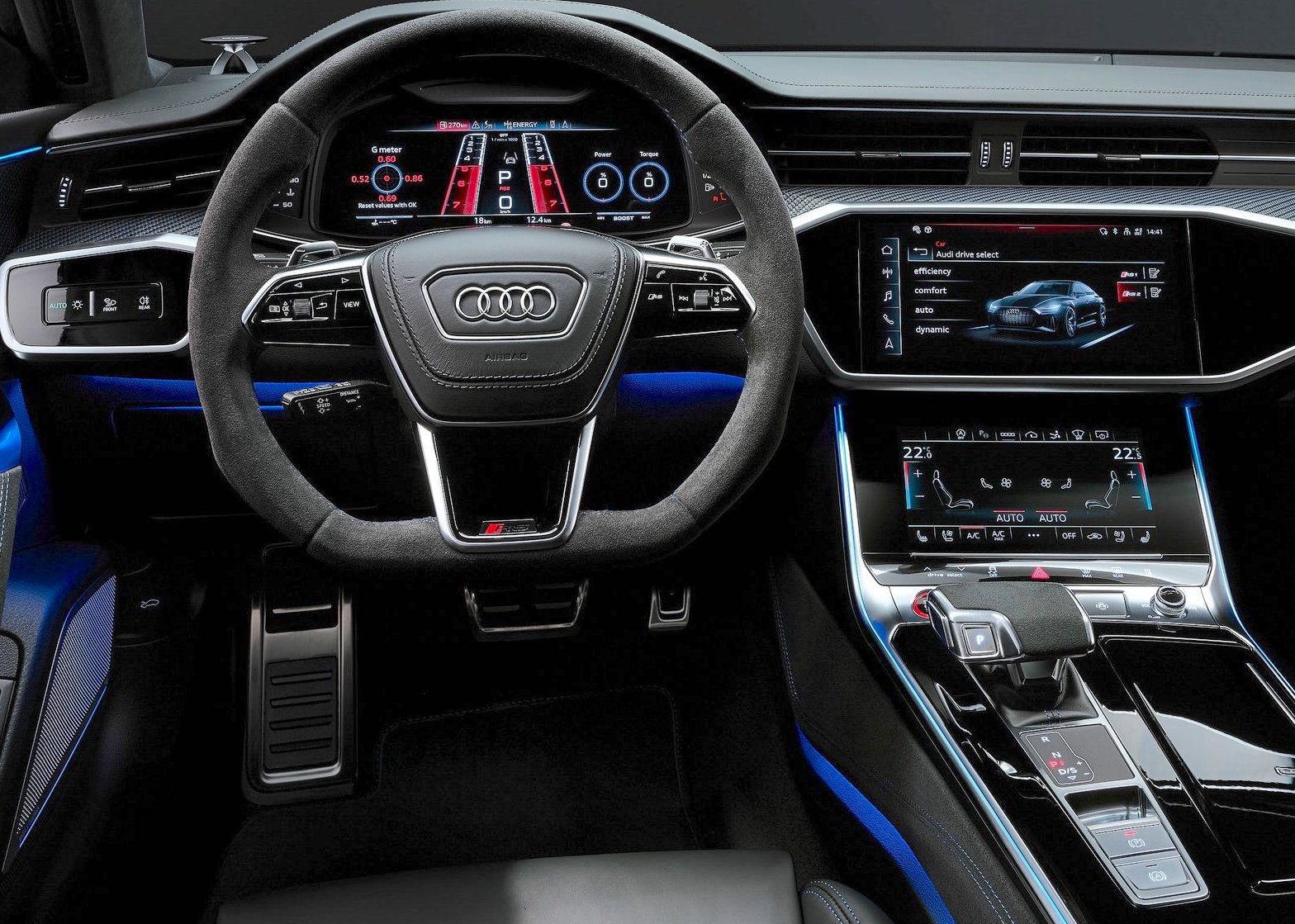
Upon request, the Audi rings and RS logos at the front and rear are also available in glossy black for the black and carbon styling packages. For a more understated look, it is also possible to request that the Audi rings and RS badges be omitted entirely. The diverse Audi exclusive range offers additional possibilities for personalization.
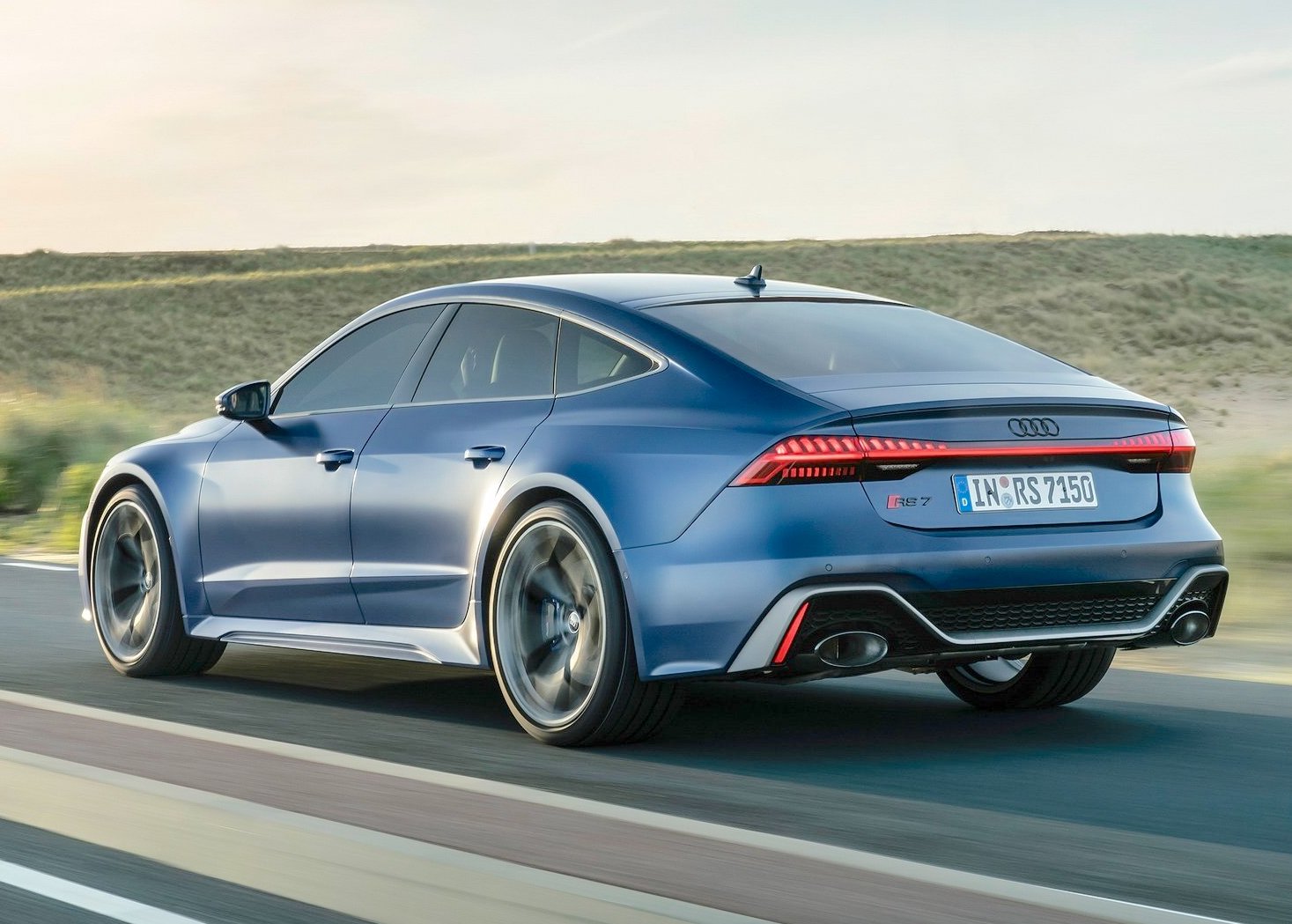
Fresh exterior colors and styling packages for the Audi RS7 Performance
The new Audi RS7 Sportback ‘Performance’ is available in a total of 16 exterior colors – for the first time, metallic and matte Ascari Blue and matte Dew Silver are included. The performance models stand out with standard RS exterior components in matte gray, including the exterior mirrors, the front spoiler, the front side flaps, the side sill inserts, the roof rails, and the trim on the side windows and rear diffuser. A matte carbon/black styling package is also an option, in which the roof rails and trim on the side windows are black. The Audi rings and model name is available in the customer’s choice of chrome or black.
Engine
The 4.0 TFSI in the Audi RS7 Sportback delivers 600 metric hp) and a constant 800 Nm of torque across a wide engine speed range from 2,050 to 4,500 rpm. The high performance Sportcoupé will sprint from 0 to 100 km/h in only 3.6 seconds and will continue on to 200 km/h in just 12 seconds. The top speed is electronically limited to 250 km/h.
Larger turbochargers and an increase in boost pressure from 2.4 to 2.6 bar in the 4.0-liter V8 biturbo TFSI engine that the Audi RS7 Sportback ‘Performance’ boast, allow an increase of 30 PS in engine power and 50 Nm more torque compared to the base versions. This means a total increase in power from 441 kW (600 PS) to 463 kW (630 PS) and in maximum torque from 800 to 850 Nm. The performance model sprint from 0 to 100 km/h in 3.4 seconds, 0.2 seconds faster than the RS7 base version.
The twin-turbo V8 engine has a conventional 90-degree bank angle and a displacement of 3,996 cc (bore x stroke: 86.0 x 86.0 millimeters (3.4 in x 3.4 in)). Its crankcase is made of cast aluminum and weighs just 39.1 kilograms (86.2 lb). The cylinder linings have been machined with the aid of atmospheric plasma spraying. This method involves applying an extremely thin iron coating to the cylinder linings. These coated cylinder linings improve heat dissipation, thermal and mechanical resilience, and wear resistance. They also significantly reduce internal friction and oil consumption. An electronic valve located centrally in the inside V also regulates the map-controlled piston spray nozzles as required for piston cooling.
When the driver steps on the accelerator, the belt alternator starter will start the engine again. MHEV technology allows for start/stop operation at a speed of up to 22 km/h (13.7 mph). In everyday driving, it is possible to achieve fuel savings of up to 0.8 liters per 100 kilometers.
The cylinder on demand (COD) system is another measure onboard the vehicle that benefits efficiency. In higher gears at low to medium loads and engine speeds, it will switch off cylinders 2, 3, 5, and 8 by halting injection and ignition and closing the intake and exhaust valves. In four-cylinder operation, the operating points in the active cylinders are shifted toward higher loads in areas of the ECU map with higher efficiency, while the deactivated cylinders largely run without losses, like gas springs. They are reactivated immediately when the driver presses the accelerator. Each switchover takes mere milliseconds and is virtually undetectable by the driver and passengers.
The twin-turbocharged four-liter-V8 engine in the Audi RS7 Sportback and the Audi RS7 Sportback ‘Performance’ produces a full-bodied and sporty V8 sound. The driver can precisely influence the sonorous sound of the power unit via the Audi drive select dynamic handling system. The optional RS sport exhaust system with black tailpipe trim provides an even fuller sound. In the customizable RS1 and RS2 modes, customers decide themselves whether the sound should be sporty or balanced.
Transmission
The power produced by the 4.0 TFSI is delivered via the standard eight-speed tiptronic transmission with optimized gear changing and a launch control function to the quattro permanent all-wheel drive system. Drive forces are distributed to the front and rear axles in a 40 : 60 ratio via the purely mechanical center differential. In the event of slip, more drive torque automatically goes to the axle with the better traction. Up to 70 percent can be directed to the front wheels and up to 85 percent to the rear wheels.
Wheel-selective torque control, a software system that operates on all kinds of road surfaces, optimizes the agile and confident handling of the RS7 Sportback and RS7 Sportback performance. It electronically applies the brakes to the wheels in a gentle manner on the inside of the bend before they can begin to slip. The difference in drive forces turns the car into the bend, allowing the car to follow the steering angle precisely. The result: precise, agile, and neutral handling.
In the optional RS dynamic package and RS dynamic package plus, Audi combines wheel-selective torque control with the quattro sport differential. It distributes the drive torque between the rear wheels as needed during dynamic cornering, thereby improving handling, traction, and stability. A superposition gear comprising two sun gears and an internal gear was mounted on the left and the right of a conventional rear differential. It turns 10 percent faster than the drive shaft.
A multi-plate clutch in an oil bath and operated by an electrohydraulic actuator provides the power connection between the shaft and the superposition gear. When the clutch closes, it steplessly forces the higher speed of the superposition stage on the gear. Being forced to turn faster results in the additional torque required being drawn off from the opposing wheel on the inside of the curve via the differential. In this way nearly all of the torque can be directed to one wheel.
The sport differential can distribute the torque between the left and right rear wheels in all operating states, including while decelerating. When turning or accelerating in a curve, they are predominantly steered toward the wheel on the outside of the curve – the car is literally pressed into the curve, eliminating even the slightest hint of understeer. In case of oversteer, the sport differential stabilizes the vehicle by shifting torque to the wheel on the inside of the curve.
In the RS7 Sportback and the RS7 Sportback ‘Performance’, the sport differential is controlled from the electronic chassis platform. The software for the sport differential constantly computes the distribution of torque at the rear axle that is ideal for driving dynamics. This takes into account the steering angle, yaw rate, lateral acceleration and driving speed. Networking with Audi drive select allows the driver to influence how the system works.
RS Dynamic Package as standard
The RS Dynamic Package is standard equipment in the RS7 performance. This includes the increase in top speed to 280 km/h (174 mph), dynamic all-wheel steering (the RS-specific software update helps the driver with active steering corrections on the front and rear axles), and the quattro sport differential on the rear axle.
The RS Dynamics Package plus is also available as an option, which in addition to the RS Dynamics Package, raises the top speed to 305 km/h (189.5 mph) and includes an RS ceramic brake system. Customers can order the calipers in gray, red, or blue and discs measure 440 mm (17.3 in) at the front and 370 mm (14.6 in) at the rear. The RS ceramic brake system weights a total of approx. 34 kg (75.0 lbs) less than its steel counterpart for a reduction of the unsprung mass.


